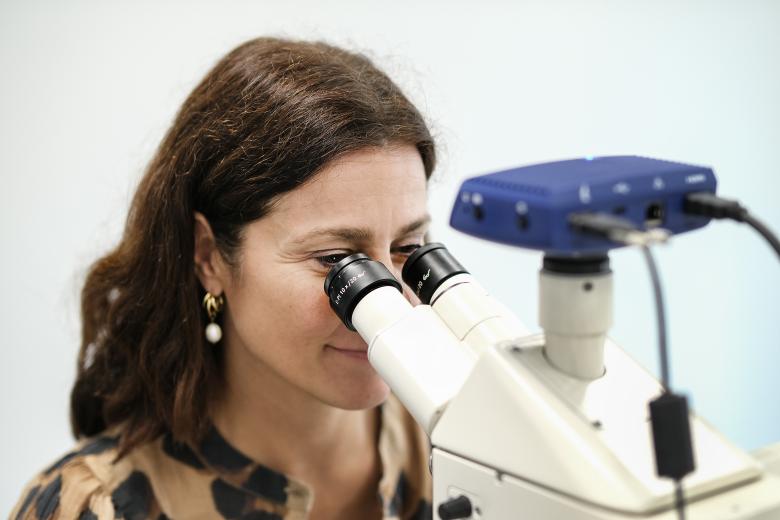Deep Brain Stimulation to treat tinnitus
A new tinnitus treatment using Deep Brain Stimulation is being trialled at MUMC+ with promising results. PhD student Jana Devos and Assistant Professor Mark Janssen on the mysterious disease, brain implants and startled rats.
An unceasing, monotonous sound without an identifiable source, tinnitus can be debilitating and its causes are somewhat mysterious. “A small minority of tinnitus sufferers have a blood vessel or a tumour near the auditory nerve, but in 99% of the cases, there’s no physical reason in the ear that we know of,” explains Jana Devos and adds that sufferers going deaf can still hear their tinnitus. “We can see that sufferers have different brain activities; we’re just not sure of the mechanism and reason.”
Around 4% of the population suffer from tinnitus – but as much as 20% might have it. In evolutionary terms, hearing is an alarm system that triggers stress when sudden changes occur. The brain is quite good at ignoring constant noises. “This filtering mechanism might explain why not everyone with tinnitus suffers from it. You might find a ticking clock annoying at first, but not notice it anymore after a bit. Tinnitus sufferers’ brains never interpret the sound as safe – it always remains an alarm signal.”
A sound approach
Devos is a research psychologist by training. She was most interested in the application of psychology in medical settings, in particular medically unexplained symptoms such as chronic pain and tinnitus. After becoming a researcher at FPN, she switched to a Neuroscience PhD. At MUMC+, she provides cognitive behavioural therapy as part of an interdisciplinary tinnitus group ranging from audiologists to social workers. “We want to understand and treat the disease holistically. To lessen the burden, patients often engage in behaviours which are more damaging than tinnitus itself.”
Devos’ PhD research is on deep brain stimulation (DBS) to treat tinnitus. This involves surgically implanting electrodes producing electrical impulses that affect activity in specific areas of the brain. “We target the main auditory-responsive portion of the thalamus, the medial geniculate body (MGB). Again, we’re not entirely sure how it works exactly but by overstimulating the overactive brain area, we’re interrupting the signal and thus suppress the activity responsible for generating the tinnitus sound.”
The working hypothesis is that tinnitus is related to hearing loss. A lack of stimulation in the part of the brain where the frequency in question is processed leads to the brain upregulating the central gain of the auditory pathway to compensate for the absence of a signal. Devos has recently published the case report of the first patient, who had the surgery a year ago.
Promising but preliminary
“The results are promising: the patient has a significantly lower burden score. For example, the VAS score [visual analogue scale: a psychometric measurement instrument for the subjective experience of suffering] went from 95 to 35, which is great. Of course, the sample size is too small to say anything about efficacy yet.” Only six patients will be included and the trial is now closed to further referrals. Thus far, they can conclude that the procedure is safe and that there are no side effects from what is literally brain surgery.
After an extensive screening process to make sure patients were suitable and all other treatment options had been exhausted, selected patients have their MRI and CT scans overlaid to know the exact coordinates of the MGB. A surgeon drills two little holes into the skull, through which the electrodes are inserted gradually. Once in place, the electrodes can be used to measure activity in the MGB with and without stimulation. “In addition to treating the condition, this also allows us to study it better.”
During the second surgery, the wires sticking out of the patient are placed under the skin, behind the ear, over the collarbone and to the belly where they are connected to an internal pulse generator often referred to as ‘battery’. Once the battery is turned on, the MGB is stimulated continuously. “If we manage to replicate the results from the first patients, then I’ll be very excited about the potential of this approach!”
DBS deep dive
“DBS has already been used for the tremors of Parkinson’s disease but this is the first trial focusing on the auditory system,” Devos explains. She’s building on her predecessors’ work in rat models that had established the method as safe and working. Her supervisor, Mark Janssen, points out that DBS has been around for 30 years. “It started in a lab in Grenoble. I was lucky enough to work with one of those pioneers. In Maastricht, we have a good 25 years of experience using DBS for various diseases.”
Janssen explains how animal studies established this DBS treatment for use in humans: “The rat is anaesthetised and tinnitus is induced in one ear through acoustic noise trauma, basically exposure to a very loud sound. After the surgical procedure to implant the electrodes, the rats are put onto a platform with a Piezo transducer, a device that measures force applied to the floor and thus how startled the animal is.”
To assess tinnitus, rats are exposed to a continuous background noise and then a loud sound to startle them. If the startling sound is preceded by short interval of silence, the animal is warned and startle response is thus reduced. “However, the rats with tinnitus are just as startled because the tinnitus fills the gap and the animal is not warned. When we applied DBS, the normal startling reflex was restored because the tinnitus no longer masked the silent interval.”
“This research line is a really good example of taking a problem many patients suffer from to the lab and then back to patients,” says Janssen and approvingly mentions the NWO’s policy of concentrating funding around the issues that affect the most people. While obviously aiming to make a difference to patients’ quality of life, the neurophysiological imaging data collected from this trail might also help identify the neural signature of tinnitus, which in turn might open the door to other forms of less invasive treatments.
By: Florian Raith
Mark Janssen is Assistant Professor of Neuroscience at MHeNs (School for Mental Health and Neuroscience) as well as a neurologist and clinical neurophysiologist at MUMC+ specialised in electrophysiology and translational research incorporating human and preclinical studies.

Also read
-
Fresh air
Newly appointed professor Judith Sluimer (CARIM) talks about oxygen in heart functioning and the 'fresh air' the academic world needs.

-
Özge Gökdemir and Devrim Dumludağ reveal differences in competitive behaviour between women in the Netherlands
Economists and spouses Dr Özge Gökdemir and Professor Devrim Dumludağ conducted a study for Maastricht University that reveals differences in competitive behaviour between women in the Netherlands. Their findings will be published soon in a scholarly journal. Here, they give us a sneak peek.

-
What exactly is Open Science?
Open Science proposes openness about data, sources and methodology to make research more efficient and sustainable as well as bringing science into the public. UM has a thriving Open Science community. Dennie Hebels and Rianne Fijten talk about progress, the Open Science Festival and what...
